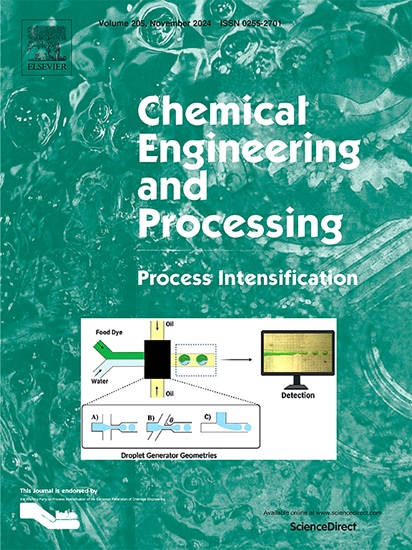Direct extraction of lithium from α-spodumene by alkali mechanochemical conversion and water leaching
IF 3.9
3区 工程技术
Q3 ENERGY & FUELS
Chemical Engineering and Processing - Process Intensification
Pub Date : 2025-07-06
DOI:10.1016/j.cep.2025.110438
引用次数: 0
Abstract
As a main component in lithium-ion batteries, lithium is crucial for the energy transition. This work investigated the use of mechanochemistry to extract lithium directly from α-spodumene, thus bypassing the energy-intensive stages of decriptation to β-spodumene and roasting. The investigated method is based on mechanochemical milling with sodium hydroxide and water leaching. A full factorial design was implemented to study the effect of milling media size (2–10 mm) and NaOH-ore mass ratio (1.5–8.5) on lithium extraction. ANOVA was conducted to assess the statistical significance of the obtained results. The lithium extraction upon mechanochemical conversion ranged from 20 to 74 %, with the highest extraction observed with 10 mm milling balls and a NaOH-ore ratio of 8.5. XRD results highlighted the disappearance of α-spodumene, with increase in amorphous content and formation of sodium aluminosilicate. FTIR revealed the formation of sodium and lithium carbonates as well as the partial cleavage of the Si-O-Si bonds in α-spodumene. All results suggest that the extraction of lithium from α-spodumene take place upon (i) Li-Na replacement in the mineral structure of α-spodumene and (ii) complete alkali conversion, both resulting in the formation of a water-soluble lithium product.

碱-机械化学转化-水浸直接萃取α-锂辉石中的锂
作为锂离子电池的主要组成部分,锂对能源转型至关重要。本文研究了利用机械化学直接从α-锂辉石中提取锂的方法,从而绕过了描述β-锂辉石和焙烧的能量密集阶段。所研究的方法是基于氢氧化钠机械化学磨矿和水浸。采用全因子设计研究磨矿介质尺寸(2 ~ 10 mm)和NaOH-ore质量比(1.5 ~ 8.5)对锂提取的影响。采用方差分析(ANOVA)评估所得结果的统计学显著性。机械化学转化后的锂提取率为20% ~ 74%,10 mm磨球和8.5 NaOH-ore比的锂提取率最高。XRD结果表明α-锂辉石消失,无定形含量增加,形成硅酸铝钠。FTIR显示α-锂辉石中碳酸钠和碳酸锂的形成以及Si-O-Si键的部分解理。结果表明,α-锂辉石中锂的提取发生在(i) α-锂辉石矿物结构中的Li-Na置换和(ii)完全碱转化过程中,形成水溶性锂产物。
本文章由计算机程序翻译,如有差异,请以英文原文为准。
求助全文
约1分钟内获得全文
求助全文
来源期刊
CiteScore
7.80
自引率
9.30%
发文量
408
审稿时长
49 days
期刊介绍:
Chemical Engineering and Processing: Process Intensification is intended for practicing researchers in industry and academia, working in the field of Process Engineering and related to the subject of Process Intensification.Articles published in the Journal demonstrate how novel discoveries, developments and theories in the field of Process Engineering and in particular Process Intensification may be used for analysis and design of innovative equipment and processing methods with substantially improved sustainability, efficiency and environmental performance.

 求助内容:
求助内容: 应助结果提醒方式:
应助结果提醒方式:


